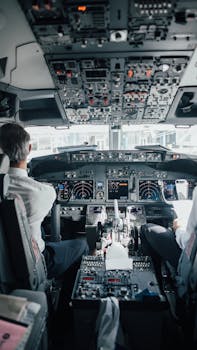
**
The recent spate of highly publicized "AI crashes" has sent shockwaves through the autonomous driving industry and sparked intense public debate. These incidents, involving self-driving cars from various manufacturers, raise critical questions about the reliability and safety of artificial intelligence in critical applications. Beyond the headlines, a complex interplay of factors contributes to these failures. This article delves into the "cockpit"—the intricate software and sensor systems—to understand what happens when autonomous driving systems malfunction.
Understanding the AI Crash Phenomenon: Beyond the Headlines
The term "AI crash" is a simplification. These aren't simply accidents; they are complex failures stemming from the interaction of numerous sophisticated systems. Key elements contributing to these incidents include:
Sensor Fusion Failures: Autonomous vehicles rely on a complex fusion of data from various sensors: LiDAR, radar, cameras, and ultrasonic sensors. A failure in one sensor, or inconsistent data from multiple sensors (e.g., due to adverse weather conditions like heavy rain or snow, or unexpected obstacles), can lead to misinterpretations by the AI system. This can cause the vehicle to misjudge distances, speeds, or the presence of objects, resulting in a collision. This is a key area of research under the umbrella of sensor data fusion algorithms and robust sensor fusion techniques.
Software Glitches and Unexpected Inputs: The software underpinning autonomous driving is extraordinarily complex. Bugs in the code, unexpected input data, or edge cases not accounted for during testing can lead to unpredictable behavior. For example, a misinterpretation of a traffic sign, a sudden change in lighting conditions, or the presence of an unusual object (like a child's toy in the road) can trigger a cascading failure. This highlights the importance of rigorous software testing and AI safety engineering.
AI Model Limitations: Current AI models, particularly deep learning models, excel at pattern recognition but often lack the common sense reasoning abilities of humans. This limitation can lead to errors in judgment, especially in unexpected or ambiguous situations. For example, an AI might correctly identify a pedestrian but misjudge their trajectory or speed, leading to a collision. Improving the generalizability and robustness of AI models for autonomous driving remains a major challenge.
Mapping and Localization Errors: Accurate mapping and localization are crucial for autonomous vehicles to understand their position and navigate effectively. Inaccurate maps, GPS errors, or difficulties in localization in challenging environments (such as tunnels or densely packed urban areas) can lead to navigation errors and potentially collisions. Advancements in high-definition mapping and simultaneous localization and mapping (SLAM) technologies are vital to mitigate this risk.
Ethical Dilemmas and Decision-Making: Autonomous vehicles are often confronted with difficult ethical dilemmas during emergency situations. Programming an AI to make optimal decisions in such situations is a complex and ongoing challenge in the field of AI ethics and autonomous vehicle ethics.
Inside the "Cockpit": A Closer Look at the Technology
The "cockpit" of an autonomous vehicle is not a physical space but a sophisticated interplay of hardware and software systems:
Hardware: The Sensory Network
- LiDAR (Light Detection and Ranging): Uses lasers to create a 3D point cloud of the vehicle's surroundings, providing detailed information about the distance and shape of objects.
- Radar (Radio Detection and Ranging): Detects objects using radio waves, providing information about their speed and distance, even in low-light conditions.
- Cameras: Capture visual data, providing rich contextual information about the environment.
- Ultrasonic Sensors: Detect nearby objects using sound waves, useful for parking and low-speed maneuvers.
Software: The Decision-Making Engine
- Perception System: Processes data from various sensors to create a comprehensive understanding of the environment.
- Localization System: Determines the vehicle's precise location using GPS, maps, and sensor data.
- Planning System: Develops a driving plan, including route selection and trajectory generation.
- Control System: Executes the driving plan by controlling the vehicle's steering, acceleration, and braking.
The Path Forward: Mitigating Future AI Crashes
Preventing future AI crashes requires a multi-pronged approach:
- Improved Sensor Fusion: Developing more robust sensor fusion algorithms that can handle inconsistencies and failures in individual sensors.
- Advanced AI Models: Creating more sophisticated AI models that possess better common sense reasoning and adaptability to unexpected situations. This involves exploring techniques like explainable AI (XAI) to understand model decisions better.
- Enhanced Software Testing: Implementing more rigorous testing methodologies to identify and address software bugs and edge cases. This includes simulation-based testing and real-world testing under diverse conditions.
- Robust Mapping and Localization: Developing higher-precision maps and more robust localization techniques.
- Addressing Ethical Dilemmas: Establishing clear ethical guidelines for autonomous vehicle decision-making in emergency situations.
- Regulation and Oversight: Creating clear regulatory frameworks to ensure the safety and reliability of autonomous vehicles.
The development of safe and reliable autonomous vehicles is an ongoing process. Understanding the complexities involved in AI crashes and implementing the necessary improvements is critical to achieving widespread adoption of this transformative technology. The "black box" of autonomous driving is gradually becoming more transparent, but ongoing research and development are essential to ensure its safe and responsible deployment.




















